Article
Dr Ayman Al-Hendy Outlines Evolving Treatment Options, Unmet Needs in Endometriosis
Author(s):
The newest treatment option for endometriosis has benefits over the previous ones available, but there remains a need for a fertility-friendly option, said Ayman Al-Hendy, MD, professor of obstetrics and gynecology at the University of Chicago Medicine.
A newly available treatment for endometriosis has provided a longer-term option for patients, but there remains a need for fertility-friendly medical therapy, said Ayman Al-Hendy, MD, professor of obstetrics and gynecology at the University of Chicago Medicine.
In the second part of his interview with The American Journal of Managed Care® (AJMC®), Al-Hendy discussed options for second-line treatment of endometriosis and compared the newly approved relugolix/estradiol/norethisterone combination therapy to previous medications and their side effects.
In part 1 of his interview, Al-Hendy covered the economic burden of endometriosis, the health equity issues presented by the disease, and first-line treatment options.
AJMC®: What are potential options for second-line treatment of endometriosis? If we’ve tried birth control, but it's not working, where do we go next?
Al-Hendy: At the moment, I would say this space is totally given to relugolix with combination therapy. Relugolix 40 milligrams once a day with 1 milligram of estradiol and half a milligram of norethindrone acetate. This altogether is the new medication that's approved for endometriosis—Myfembree.
Each tablet of Myfembree is 40 milligrams of relugolix, 1 milligram of estradiol, and half a milligram of norethindrone acetate, all together in one tablet. The FDA approval is to use this once a day. That, for me, is definitely the second-line treatment, and for the kind of patient I see, usually they have already failed birth control. So, for me, it's the first line in a way for the kind of patient I see. Honestly, I think overall, it should be the first line, because birth control has not been validated as an effective treatment for endometriosis in high-quality large phase 3 studies. And it is certainly not FDA-approved for the treatment of endometriosis.
Myfembree is what I do prescribe for endometriosis patients. It has been approved for use up to 2 years. So, I talk to my patient, “Let's think about Myfembree as maybe a bridge to the next stage or the next part of your reproductive journey.” For example, we know pregnancy actually improves a lot the symptoms of endometriosis and actually changes the biology of the disease. If a patient has endometriosis, and they manage to get pregnant—because sometimes endometriosis also makes it difficult to get pregnant, can cause infertility—but if you manage to get pregnant and you have endometriosis, after a term, pregnancy, and delivery, for most of the patients, their endometriosis becomes dormant or inactive, at least for a long time. Pregnancy is some kind of normal physiological treatment, if we can call it that.
I tell my young patients with endometriosis about Myfembree, because it's been approved to be used for up to only 2 years, let's use it as a bridge. Then when you get pregnant on your own pace and your own time, then let's assist you after. Most of the time your symptoms will not come back, and your disease profile will change.
The same thing is true for women during the late years of reproductive life. Let's say, mid to late 40s and older, because the average age of menopause is 52. Once you hit menopause, endometriosis will just get better, because it needs the estrogen that comes from the ovaries, and menopause, by definition, the ovaries stop producing estrogen and progestin. I also counsel them to use this medication, avoid another surgery, because usually endometriosis patients, unfortunately have multiple surgeries, and by the time I've seen them, many of them already had 1 or 2 laparoscopies already. Let's avoid another surgery. Let's use this medication as a bridge into menopause. Then once they hit menopause, this will be self-limited and the endometriosis-related symptoms will just get better by themselves.
AJMC®: How does Myfembree compare to maybe some of the gonadotropin-releasing hormone (GnRH) agonists that we might have been using previously? How would you compare them thinking about the various formulations and limitations on duration of use?
Al-Hendy: Before Myfembree, if you failed birth control pills—70% or 75% do—the only option we had at that time, either to go to surgery right away or to use GnRH analog. And the only one available in the United States is the leuprolide (Lupron) injection. There are 2 major advantages with Myfembree that I really like. One, it's oral, so it's a simple prescription. The patient leaves with a simple prescription and I tell her, “Once you have it in your hand from the pharmacy, start using it.” However, Lupron is an injection. Whether she's going to use it monthly or every 3 months, she has to come back to the clinic and have an appointment with a nurse. It’s more inconvenient, there’s a parking inconvenience, which also affected compliance.
The other major advantage with Myfembree—or the relugolix in Myfembree—is that it's a GnRH antagonist. Lupron was a GnRH agonist. With Lupron, it actually made things worse before it gets better. Lupron would bind to the GnRH receptor in the anterior pituitary gland and actually stimulate it first. Then after 10 days to 2 weeks, it suppressed it. During those 2 weeks, the patient symptoms actually get worse. If her symptoms was pain, the pain gets worse. If her symptoms were heavy menstrual bleeding, it will actually get worse. We had to counsel the patient that things will get worse for 2 weeks. You just have to put up with it, then it will get better. Because if you don’t explain this, you are going to get a call from the emergency department. When I started many years ago, that's actually what happened. So, I learned my lesson, that you have to counsel your patient to understand things will get worse before they get better. With Myfembree, you don't have to worry about that. It's a pure antagonist, it binds to the receptor and inhibits it right away. You don't have to worry about things getting worse before they get better and so on.
The other major difference is Lupron alone will make the patient lose bone mineral density, because it is just going to put the estrogen in the body in the postmenopausal range, probably less than 20 picogram per milliliter. It’s a very low level of estrogen. Lupron is a very strong GnRH agonist, and it suppresses the pituitary gland. If you suppress the pituitary gland, then it suppressed the ovulation, and the ovary is stop producing estrogen and progestin. It's only approved to be used in general in women just for 3 months. Because the bone mineral density loss that you're going to have, if you use Lupron for more than 3 months, it's not going to come back. In 3 months, you're still going to lose some, but because it's a short period, if you don't continue to use it, then the bone is able to recover mostly. So, Lupron is just really a temporary relief. It's just like a Band-Aid.
Myfembree has the relugolix but it also has a little bit of estrogen. The 1 milligram actually brings the estrogen level in the serum to a much higher level, to a mid-cycle level, which is roughly about 30 to 50 picogram per milliliter. It's not enough to help the endometriosis, but it's enough to keep the bone healthy. That's why it's approved for a much longer time: 2 years. Then of course, the progestin was added just to protect the endometrin. It's a totally different formulation.
Myfembree really is a much better choice because it's safe for up to 2 years, unlike Lupron. Now, Lupron, some people improvise doing add-back therapy and so on, because none of these add-back formulations have been tested in large studies. So, everybody kind of had their own preferred regimen. Some add medroxyprogesterone acetate (Depo-Provera), some add birth control that is low hormonal, low estrin. It's very confusing. None of that is based on large studies, and that's why the results were quite variable. While Myfembree’s exact formulation has been evaluated in large, well-done phase 3 studies, so that's why I like that.
AJMC®: What would you say are the biggest unmet needs in the endometriosis patient population? What barriers do patients and providers commonly encounter?
Al-Hendy: There are several really, but at the top, I would put diagnosis—having a better diagnostic tool, which probably is not going to be imaging, unless the imaging technology improves so much. Most of the endometriosis is just really a flat layer on top of the uterus, on top of the ovary, and there’s not a significant amount of lesions that you can see. It's probably going to have to come in the form of something we test in the blood or the urine: a biomarker. I know there's a lot of research on that. Finding a single biomarker would be amazing, but even a combination of few different biomarkers, microRNAs, cytokines, etc, would be helpful. Unfortunately, so far, none of them are really reliable as a diagnostic tool. Yes, something might be elevated in endometriosis, but in normal women there's a lot of variation, so there's no clear separation. There's a lot of overlap.
I think an improvement with a diagnostic tool, whether it's a biomarker or imaging, will help us. The patient comes in, we test with whatever this new test is, and then we know for sure she has endometriosis. That would be a huge improvement in helping and serving our patient. Because we can have the diagnosis right away instead of, unfortunately, 7 years later, and then we can start effective treatments right away.
AJMC®: What are you working on in endometriosis that you're excited to share?
Al-Hendy: Another unmet need in endometriosis is a fertility-friendly medical therapy. So, now we have Myfembree, and hopefully, we'll have more medical, non-surgical options in the future. Unfortunately, because they're all hormonals, while the patient is using them, she cannot try to get pregnant. If somebody has endometriosis, and she has infertility, and she wants to get medical treatment to help her get pregnant. We tell her, “We're going to use this medication for 6 months or a year to suppress your endometriosis, but during that time you won't be able to get pregnant. It’s just the way the medication works; you're not going to ovulate. But after those 6 months or a year, we'll stop, your ovary will become active, but since the endometriosis has been dormant for a while, you have a window, maybe for a few months, before the endometriosis wakes up again.” The endometriosis will come back unfortunately until the patient reaches menopause. But they have that window of probably 6 months or so to try to get pregnant.
That's a lot of kind of stress and pressure on the patient, and also a lot of aerobics, on and then off and so on. If we can come up with a nonhormonal treatment for endometriosis that can kill or suppress the endometriosis without affecting the fertility potential of the patient, without suppressing ovulation, without affecting the uterus, that would be super helpful and amazing for our patients.


